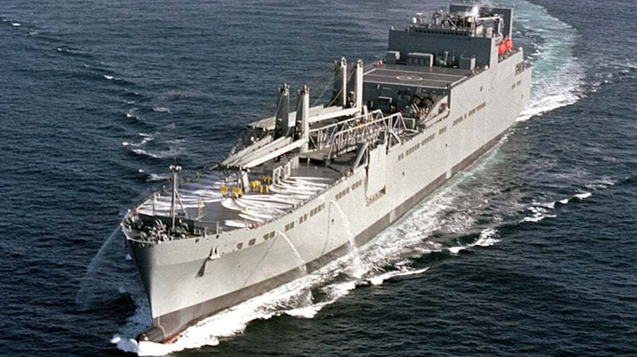STRATEGIC MILITARY SEALIFT IS CRITICAL
 Strategic sealift is an essential element of the U.S. military’s logistics system. Sealift provides weaponry, fuel, ammunition, and other support needed for warfighting on the battlefield. Roughly 90% of all needed supplies and equipment travel by sea.
Strategic sealift is an essential element of the U.S. military’s logistics system. Sealift provides weaponry, fuel, ammunition, and other support needed for warfighting on the battlefield. Roughly 90% of all needed supplies and equipment travel by sea.
There is no viable alternative to sea transport. The distances are too great and the vast tonnages of military weapons and support equipment dictate transportation by sea. What is logistics, and why is it important? Let’s hear from some historical figures on the importance of logistics:
“Logistics [is] … as vital to military success as daily food is to daily work.” —Rear Admiral Alfred Thayer Mahan (USN)
“Amateurs worry about strategy. Dilettantes worry about tactics. Professionals worry about logistics.” —Unknown
“You will not find it difficult to prove that battles, campaigns, and even wars have been won or lost primarily because of logistics.” —General Dwight D. Eisenhower
“I don’t know what the hell this logistics is that [Gen.] Marshall is always talking about, but I want some of it.” —Admiral E.J. King (USN)
“My logisticians are a humorless lot. … They know if my campaign fails, they are the first ones I will slay.” —Alexander the Great
All humor aside, the importance of sea transport of our military assets to war cannot be overemphasized. Future conflict in the Indo-Pacific with the People’s Republic of China (PRC) looms. U.S. treaty allies of Japan, the Philippines, South Korea, and Australia are threatened by the PRC’s ambition to dominate and control the Pacific. Equally important are our obligations to Taiwan under the provisions of the Taiwan Relations Act of 1979, which states, “The United States will make available to Taiwan such defense articles and defense services in such quantity as may be necessary to enable Taiwan to maintain a sufficient self-defense capability.” Support for our allies will require massive amounts of sealift.
The U.S. military maintains a robust presence in the Indo-Pacific with approximately 50-60 ships at any given time, along with significant Army, Marine, Air Force, and Special Forces assets. But, if war breaks out, the forces now there would need to be quickly augmented with significant additional weapons and support. Strategic military sealift now consists of the following:
Maritime Prepositioning Ships: “The Navy’s 14 Maritime Prepositioning Ships (MPS) are part of Military Sealift Command’s Prepositioning Program,” the Navy explains. “These ships preposition U.S. Marine Corps vehicles, equipment, and ammunition throughout the world.” These ships primarily support USMC and Navy surge assets that would support USINDOPACOM. The ships are preloaded with equipment and arms and are now located at Diego Garcia in the Indian Ocean, in the Mediterranean, and at Guam and Saipan. They are the designed quick reaction force to reinforce forces already in theater.
The Maritime Administration: The Maritime Administration, which is part of the U.S. Department of Transportation, is responsible for strategic sealift in support of our military. Yes, the transportation of most of the surge assets does not reside in the military! Since 1981, DOD has had to rely on another executive department to transport its assets.
According to the Maritime Administration (MARAD), “The Ready Reserve Force (RRF) is a subset of vessels within MARAD’s National Defense Reserve Fleet (NDRF) ready to support the rapid worldwide deployment of U.S. military forces. As a key element of DOD strategic sealift, the RRF primarily supports transport of Army and Marine Corps unit equipment, combat support equipment, and initial resupply during critical surge periods — the period of time before commercial ships can be secured for similar support.”
The RRF consists of 48 ships:
- 42 roll-on/roll-off (RO/RO) vessels, including eight Fast Sealift Support (FSS) vessels and seven LMSR’s (Large, Medium-Speed, Roll-on/Roll-off)
- Four auxiliary craneships
- Two aviation repair vessels
In the entire National Defense Reserve Fleet, there are only about 100 ships. At the end of WWII, the U.S. strategic transportation fleet numbered over 2,200 ships. The requirement for the RRF is that those “ready” ships be manned and ready to go to sea in 5-10 days. The readiness of the remaining ships in the NDRF is much less. In a test in 2019, MARAD activated 33 NDRF ships, and less than half were ready when needed. No test has been done since then. Defense News reported on that test. In addition to the significant lack of ready ships, the U.S. has far fewer mariners than we need and even has trouble manning the few ships that are operating today. During WWII, the U.S. had 250,000 civilian mariners. Today, we have less than 12,000, and as far back as 2017, DOT identified the lack of enough mariners to man the ships as a significant problem. The problem of insufficient numbers of ships and mariners has not been solved.
If war breaks out in the Pacific or elsewhere, we will fight with the forces we already have in theater with the slight augment provided by the MPF ships. This is a recipe for disaster. The U.S. urgently needs to buy or construct additional strategic sealift ships to support our national policy of defending our allies. To not have provided for these ships beforehand is a negligent strategic blunder, especially in light of their relatively low cost. The Navy estimated that it could buy suitable used commercial transports for a tiny fraction of the cost of building new ships.
Simply put, the U.S. needs more strategic sealift.
Brent Ramsey writes for The Epoch Times.

